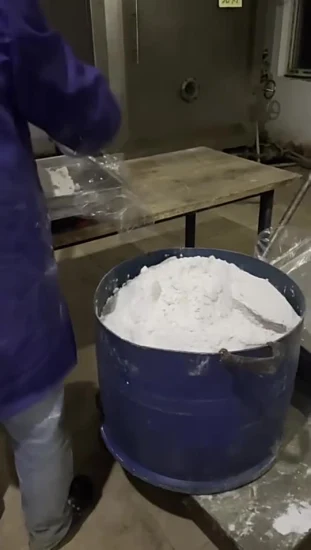
Porcine Lithium Heparin Fine Chemical Analysis Purity Level
Packaging Specification : 10g/bottle,20g/bottle,50g/bottle Basic Information Heparin lithium is a chemical substance wit
Description
Basic Info.
| Model NO. | DS0328 |
| Water Solubility | Soluble |
| Molecular Weight | 0 |
| Purity | Above 99% |
| Storage Conditions | Room Temp |
| Transport Package | Carton |
| Specification | 10g/bottle, 20g/bottle, 50g/bottle |
| Trademark | DeSheng |
| Origin | Ezhou City, Hubei Province, China |
| Production Capacity | 20 Kg Per Month |
Product Description
Packaging Specification : 10g/bottle,20g/bottle,50g/bottle
Basic Information
| Appearance | White crystal powder |
| Place of Origin | Ezhou City, Hubei Province |
| Soluble | Water: 125 mg/mL |
| Dissolution | Easily soluble in water |
| Titer | 150IU/mg |
| Main use | Used as an external anticoagulant for blood |
Heparin lithium is a chemical substance with a white to almost white powder appearance. There was no statistically significant difference in the detection results of TP, ASO, UA, ALT, Mg, Cl, TC, CRP between heparin lithium anticoagulant plasma and serum (P>0.05). There was a statistically significant difference in the detection results of HBD, LDH, and TChemicalbookBA between heparin lithium anticoagulant plasma and serum (P<0.05). Therefore, except for HBD, LDH, and TBA, the correlation between heparin lithium anticoagulant plasma and serum is good. Therefore, the feasibility of using heparin lithium anticoagulant plasma instead of serum in daily life testing is high, and it can be used as an important detection method.
Preparation of heparin lithium
1. Crude heparin enzymatic hydrolysis: Dissolve crude heparin sodium, adjust the pH value to 7.5-9.0, raise the temperature to 50-55 ºC, add heparin enzyme to hydrolyze pancreatic enzyme, keep it for 4-5 hours, adjust the pH value to 9.0-11, raise the temperature to 85 ºC~90 ºC, cool, filter to remove sediment, precipitate the filtrate with ethanol, and collect sediment (A);2. Deproteinization: Dissolve the precipitate (A) obtained in step 1 with water, stir, adjust the pH to 9-11, add protein coagulant, stir, let stand, filter to remove the precipitate, collect the filtrate (D), adjust the pH of the filtrate (D) to 11-13, stir, let stand, filter to remove the precipitate, collect the filtrate (E), adjust the pH of the filtrate (E) to neutral, precipitate with ethanol, and collect the precipitate (ChemicalbookB);3. Oxidative decolorization: Dissolve the precipitate (B) obtained in step 2 in water, oxidize it with hydrogen peroxide for 24-48 hours, adjust the pH to 10.5-11.5, filter to remove the precipitate, collect the filtrate (F), adjust the pH of the filtrate (F) to 6.5-7.5, precipitate with ethanol, and collect the precipitate (C);4. Resin exchange: Dissolve the precipitate (C) obtained in step 3 with water, add LiCl, stir for dissolution, exchange ions through a resin column, collect the effluent from the column, and obtain a heparin lithium solution;5. Precipitation, dehydration, and drying: Filter the heparin lithium solution obtained in step 4, precipitate with ethanol, collect the precipitate (G), dehydrate the precipitate (G), and then vacuum dry and crush to obtain a high-quality heparin lithium product.
Physical and chemical propertiesAlthough sodium and lithium are both alkali metals, lithium is composed of two stable isotopes Li6 and Li7. The conductivity of Li/10E6/cm: 0.108, the number of nuclear charges 3, and the extranuclear electron layer 1. Lithium has small density and viscosity, while Li7 has the advantage of small neutron capture area, which is only 6.2% of sodium. Lithium has fewer electrons and is relatively stable, so it is slower to combine with PLT than heparin sodium. The conductivity of sodium/10E6/cm: 0.21, nuclear charge number 11, and outer electron layer 6. From the comparison of these three values of the two elements, lithium has more stable chemical properties than sodium. Sodium has more nuclear charges and aggregates more quickly with negatively charged PLTs than heparin lithium.
Full series of blood collection additives produced by Desheng
| Order number | Product name | CAS Number |
| 1 | Serum Separating Gel | / |
| 2 | Sodium Heparin | 9041-08-1 |
| 3 | Lithium Heparin | 9045-22-1 |
| 4 | EDTA K2 | 25102-12-9 |
| 5 | EDTA K3 | 65501-24-8 |
| 6 | EDTA Na2 | 6381-92-6 |
| 7 | Blood Clot Activation | / |
| 8 | Blood Clot powder | / |
| 9 | Water Soluble Silicone Release Agent | / |
| 10 | High effective Silicone release agent | / |
| 11 | Potassium oxalate monohydrate | 6487-48-5 |
| 12 | Trisodium citrate dihydrate | 6132-04-3 |
Company IntroductionHubei New Desheng Material Technology Co., Ltd. specializes in the production of blood collection tube additives, chemiluminescent reagents, biological buffers, chromogenic substrates, enzyme preparations, antigen antibodies and other biochemical reagents. Founded in 2005, Desheng has a professional R&D team and advanced production equipment!
Our Contact
Send now






